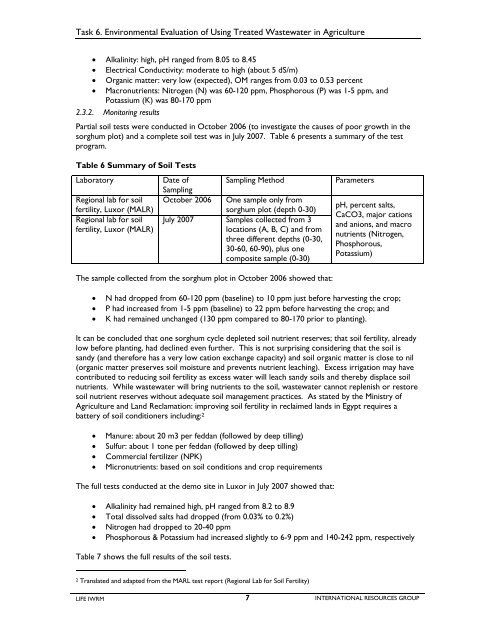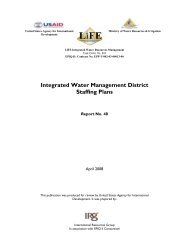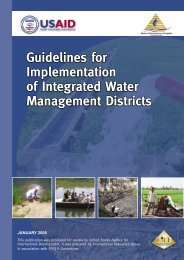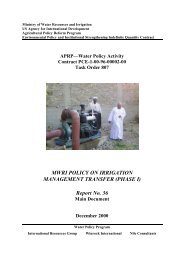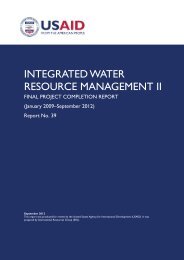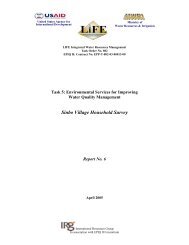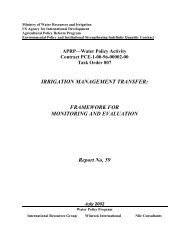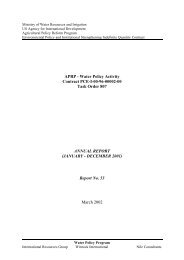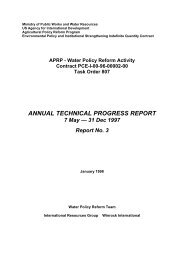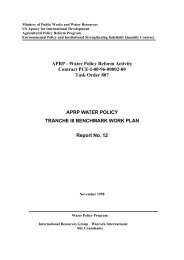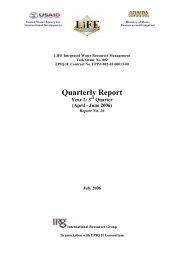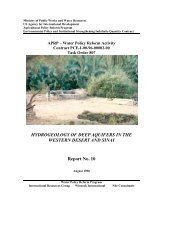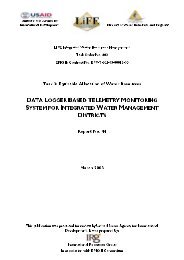Report 45 Task 6 Environmental Evaluation Luxor Demo Site
Report 45 Task 6 Environmental Evaluation Luxor Demo Site
Report 45 Task 6 Environmental Evaluation Luxor Demo Site
Create successful ePaper yourself
Turn your PDF publications into a flip-book with our unique Google optimized e-Paper software.
<strong>Task</strong> 6. <strong>Environmental</strong> <strong>Evaluation</strong> of Using Treated Wastewater in Agriculture<br />
• Alkalinity: high, pH ranged from 8.05 to 8.<strong>45</strong><br />
• Electrical Conductivity: moderate to high (about 5 dS/m)<br />
• Organic matter: very low (expected), OM ranges from 0.03 to 0.53 percent<br />
• Macronutrients: Nitrogen (N) was 60-120 ppm, Phosphorous (P) was 1-5 ppm, and<br />
Potassium (K) was 80-170 ppm<br />
2.3.2. Monitoring results<br />
Partial soil tests were conducted in October 2006 (to investigate the causes of poor growth in the<br />
sorghum plot) and a complete soil test was in July 2007. Table 6 presents a summary of the test<br />
program.<br />
Table 6 Summary of Soil Tests<br />
Laboratory<br />
Date of<br />
Sampling<br />
Sampling Method<br />
Regional lab for soil October 2006 One sample only from<br />
fertility, <strong>Luxor</strong> (MALR)<br />
sorghum plot (depth 0-30)<br />
Regional lab for soil July 2007 Samples collected from 3<br />
fertility, <strong>Luxor</strong> (MALR)<br />
locations (A, B, C) and from<br />
three different depths (0-30,<br />
30-60, 60-90), plus one<br />
composite sample (0-30)<br />
Parameters<br />
pH, percent salts,<br />
CaCO3, major cations<br />
and anions, and macro<br />
nutrients (Nitrogen,<br />
Phosphorous,<br />
Potassium)<br />
The sample collected from the sorghum plot in October 2006 showed that:<br />
• N had dropped from 60-120 ppm (baseline) to 10 ppm just before harvesting the crop;<br />
• P had increased from 1-5 ppm (baseline) to 22 ppm before harvesting the crop; and<br />
• K had remained unchanged (130 ppm compared to 80-170 prior to planting).<br />
It can be concluded that one sorghum cycle depleted soil nutrient reserves; that soil fertility, already<br />
low before planting, had declined even further. This is not surprising considering that the soil is<br />
sandy (and therefore has a very low cation exchange capacity) and soil organic matter is close to nil<br />
(organic matter preserves soil moisture and prevents nutrient leaching). Excess irrigation may have<br />
contributed to reducing soil fertility as excess water will leach sandy soils and thereby displace soil<br />
nutrients. While wastewater will bring nutrients to the soil, wastewater cannot replenish or restore<br />
soil nutrient reserves without adequate soil management practices. As stated by the Ministry of<br />
Agriculture and Land Reclamation: improving soil fertility in reclaimed lands in Egypt requires a<br />
battery of soil conditioners including: 2<br />
• Manure: about 20 m3 per feddan (followed by deep tilling)<br />
• Sulfur: about 1 tone per feddan (followed by deep tilling)<br />
• Commercial fertilizer (NPK)<br />
• Micronutrients: based on soil conditions and crop requirements<br />
The full tests conducted at the demo site in <strong>Luxor</strong> in July 2007 showed that:<br />
• Alkalinity had remained high, pH ranged from 8.2 to 8.9<br />
• Total dissolved salts had dropped (from 0.03% to 0.2%)<br />
• Nitrogen had dropped to 20-40 ppm<br />
• Phosphorous & Potassium had increased slightly to 6-9 ppm and 140-242 ppm, respectively<br />
Table 7 shows the full results of the soil tests.<br />
2 Translated and adapted from the MARL test report (Regional Lab for Soil Fertility)<br />
LIFE IWRM 7<br />
INTERNATIONAL RESOURCES GROUP


